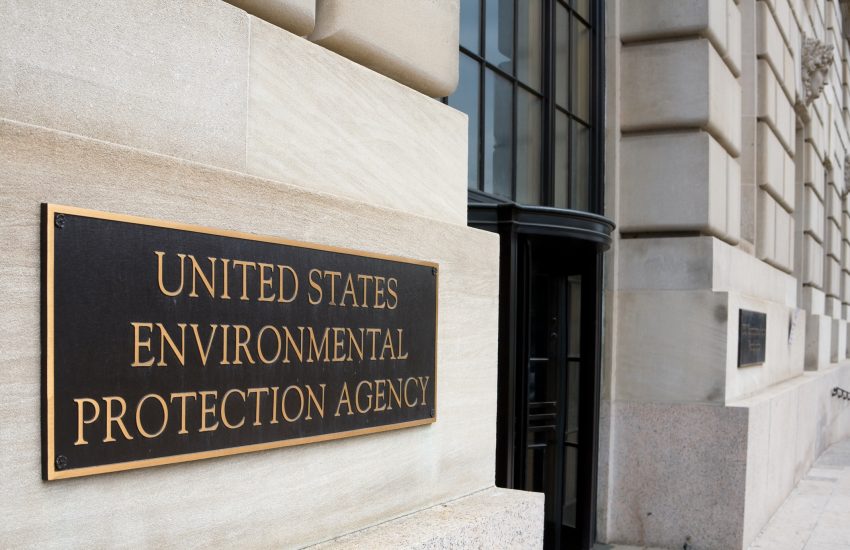The Environmental Protection Agency announced April 28 a list of upcoming agency actions to address Per- and Polyfluoroalkyl Substances (PFAS).
This week’s announcement provides a broad outline of EPA’s plans that centers around three principles: (1) strengthening the scientific understanding of PFAS, (2) fulfilling statutory obligations and enhancing communication, and (3) building partnerships.
PFAS are a class of thousands of humanmade “forever chemicals” that can last for many years in the environment. They are used in manufacturing and consumer products, such as non-stick pans, raincoats, and cosmetics. According to a 2023 U.S. Geological Survey, it is estimated that at least 45 percent of tap water in the United States is contaminated with PFAS.
The full list of PFAS actions by EPA include:
Strengthening the Science
- Designate an agency lead for PFAS to better align and manage PFAS efforts across agency programs.
- Implement a PFAS testing strategy under Toxic Substances Control Act (TSCA) Section 4 to seek scientific information informed by hazard characteristics and exposure pathways.
- Launch additional efforts on air-related PFAS information collection and measurement techniques related to air emissions.
- Identify and address available information gaps where not all PFAS can be measured and controlled.
- Provide more frequent updates to the PFAS Destruction and Disposal Guidance — changing from every three years to annually — as EPA continues to assess the effectiveness of available treatment technologies.
- Ramp up the development of testing methods to improve detection and strategies to address PFAS.
Fulfilling Statutory Obligations and Enhancing Communication
- Develop effluent limitations guidelines (ELGs) for PFAS manufacturers and metal finishers and evaluate other ELGs necessary for reduction of PFAS discharges.
- Address the most significant compliance challenges and requests from Congress and drinking water systems related to national primary drinking water regulations for certain PFAS.
- Determine how to better use RCRA authorities to address releases from manufacturing operations of both producers and users of PFAS.
- Add PFAS to the Toxic Release Inventory in line with Congressional direction from the 2020 National Defense Authorization Act.
- Enforce Clean Water Act and TSCA limitations on PFAS use and release to prevent further contamination.
- Use Safe Drinking Water Act authority to investigate and address immediate endangerment.
- Achieve more effective outcomes by prioritizing risk-based review of new and existing PFAS chemicals.
- Implement section 8(a)7 to smartly collect necessary information, as Congress envisioned and consistent with TSCA, without overburdening small businesses and article importers.
- Work with Congress and industry to establish a clear liability framework that operates on polluter pays and protects passive receivers.
Building Partnerships
- Advance remediation and cleanup efforts where drinking water supplies are impacted by PFAS contamination.
- Work with states to assess risks from PFAS contamination and the development of analytical and risk assessment tools.
- Finish public comment period for biosolids risk assessment and determine path forward based on comments.
- Provide assistance to states and tribes on enforcement efforts.
- Review and evaluate any pending state air petitions.
- Resource and support investigations into violations to hold polluters accountable.
Notably, EPA’s announcement does not expressly discuss the two major PFAS regulatory actions from the prior administration: the designation of two PFAS compounds as hazardous substances under the Comprehensive Environmental Response, Compensation and Liability Act and the promulgation of enforceable Maximum Contaminant Levels and non-enforceable health-based Maximum Contaminant Level Goals for six PFAS compounds under the Safe Drinking Water Act, both of which are currently subject to judicial challenges.
EPA’s approach also differs from the previous administration’s in several aspects, including an increased focus on air and working with Congress to propose a liability framework centered on “polluter pays” principles. Additionally, the current plan seeks to designate a single agency-wide PFAS lead rather than a multi-member EPA Council on PFAS. However, EPA’s plan may also advance certain Biden-era PFAS regulatory efforts such as the proposed rule designating nine PFAS as hazardous constituents under Resource Conservation and Recovery Act and developing ELGs for certain sectors under the Clean Water Act.
Although EPA’s list of agency actions provides very few details, including when and how these plans will be implemented, its announcement stated that this list represents only the first set of agency actions. Therefore, the regulated community should stay tuned, because it is likely the current administration is just getting started and that there are more regulatory PFAS actions to come.

